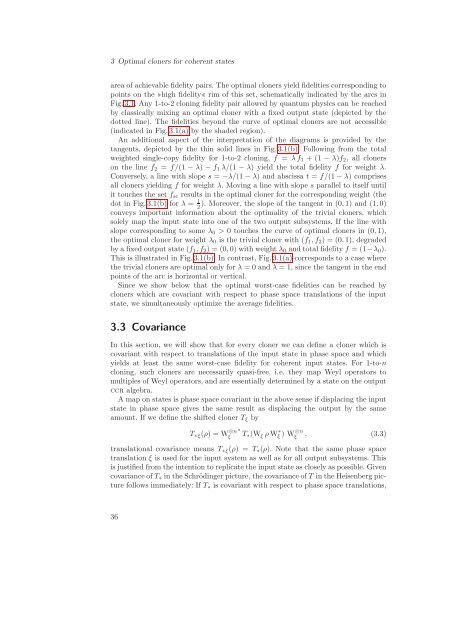Quantum Information Theory with Gaussian Systems
Quantum Information Theory with Gaussian Systems
Quantum Information Theory with Gaussian Systems
Create successful ePaper yourself
Turn your PDF publications into a flip-book with our unique Google optimized e-Paper software.
3 Optimal cloners for coherent states<br />
area of achievable fidelity pairs. The optimal cloners yield fidelities corresponding to<br />
points on thehigh fidelityrim of this set, schematically indicated by the arcs in<br />
Fig.3.1. Any 1-to-2 cloning fidelity pair allowed by quantum physics can be reached<br />
by classically mixing an optimal cloner <strong>with</strong> a fixed output state (depicted by the<br />
dotted line). The fidelities beyond the curve of optimal cloners are not accessible<br />
(indicated in Fig.3.1(a) by the shaded region).<br />
An additional aspect of the interpretation of the diagrams is provided by the<br />
tangents, depicted by the thin solid lines in Fig.3.1(b). Following from the total<br />
weighted single-copy fidelity for 1-to-2 cloning, f = λf1 + (1 − λ)f2, all cloners<br />
on the line f2 = f/(1 − λ) − f1 λ/(1 − λ) yield the total fidelity f for weight λ.<br />
Conversely, a line <strong>with</strong> slope s = −λ/(1 − λ) and abscissa t = f/(1 − λ) comprises<br />
all cloners yielding f for weight λ. Moving a line <strong>with</strong> slope s parallel to itself until<br />
it touches the set fsc results in the optimal cloner for the corresponding weight (the<br />
dot in Fig. 3.1(b) for λ = 1<br />
2 ). Moreover, the slope of the tangent in (0, 1) and (1, 0)<br />
conveys important information about the optimality of the trivial cloners, which<br />
solely map the input state into one of the two output subsystems. If the line <strong>with</strong><br />
slope corresponding to some λ0 > 0 touches the curve of optimal cloners in (0, 1),<br />
the optimal cloner for weight λ0 is the trivial cloner <strong>with</strong> (f1, f2) = (0, 1), degraded<br />
by a fixed output state (f1, f2) = (0, 0) <strong>with</strong> weight λ0 and total fidelity f = (1−λ0).<br />
This is illustrated in Fig.3.1(b). In contrast, Fig. 3.1(a) corresponds to a case where<br />
the trivial cloners are optimal only for λ = 0 and λ = 1, since the tangent in the end<br />
points of the arc is horizontal or vertical.<br />
Since we show below that the optimal worst-case fidelities can be reached by<br />
cloners which are covariant <strong>with</strong> respect to phase space translations of the input<br />
state, we simultaneously optimize the average fidelities.<br />
3.3 Covariance<br />
In this section, we will show that for every cloner we can define a cloner which is<br />
covariant <strong>with</strong> respect to translations of the input state in phase space and which<br />
yields at least the same worst-case fidelity for coherent input states. For 1-to-n<br />
cloning, such cloners are necessarily quasi-free, i.e. they map Weyl operators to<br />
multiples of Weyl operators, and are essentially determined by a state on the output<br />
ccr algebra.<br />
A map on states is phase space covariant in the above sense if displacing the input<br />
state in phase space gives the same result as displacing the output by the same<br />
amount. If we define the shifted cloner Tξ by<br />
T∗ξ(ρ) = W ⊗n∗<br />
ξ T∗(Wξ ρ W ∗ ξ ) W ⊗n<br />
ξ , (3.3)<br />
translational covariance means T∗ξ(ρ) = T∗(ρ). Note that the same phase space<br />
translation ξ is used for the input system as well as for all output subsystems. This<br />
is justified from the intention to replicate the input state as closely as possible. Given<br />
covariance of T∗ in the Schrödinger picture, the covariance of T in the Heisenberg picture<br />
follows immediately: If T∗ is covariant <strong>with</strong> respect to phase space translations,<br />
36
















